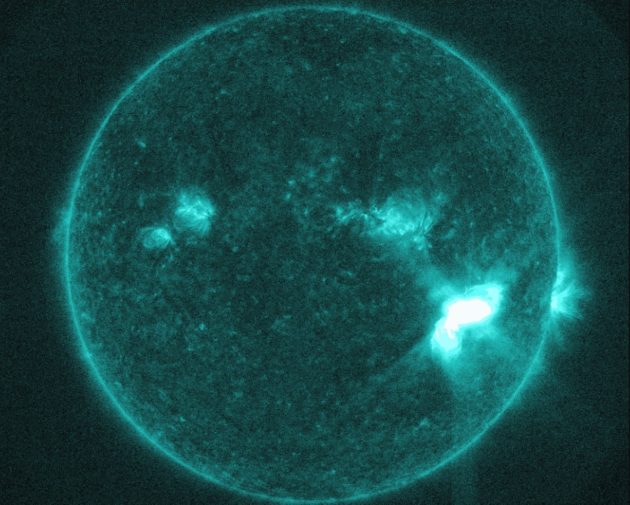
If the sun throws out a radiation blast of satellite-killing proportions someday, Amazon Web Services may well play a role in heading off a technological doomsday.
That’s the upshot of a project that has NASA working with AWS Professional Services and the Amazon Machine Learning Solutions Lab to learn more about the early warning signs of a solar superstorm, with the aid of artificial intelligence.
Solar storms occur when disturbances on the sun’s surface throw off a blasts of radiation and eruptions of electrically charged particles at speeds of millions of miles per hour. A sufficiently strong radiation blast can impact radio communications over half of the globe. And if the eruptions, known as coronal mass ejection or CMEs, are strong enough and sweep directly past Earth, they can damage satellites and bring down power grids.
The best-known recent example came in 1989 when a high-energy CME overloaded the Hydro-Quebec power grid, triggering outages for more than 6 million people in Canada and the eastern U.S.
But that’s not the worst that the sun can do: Scientists and historians point to an 1859 superstorm known as the Carrington Event, which wrought havoc with telegraph systems and created auroral displays so bright that folks in the northeastern U.S. were said to be able to read newspapers by their light. Today, a storm of that magnitude would deal a heavy blow to our wired (and wireless) world.
We’re not defenseless against solar storms: Sun-observing satellites like NASA’s Solar Dynamics Observatory and the Advanced Composition Explorer can warn of an incoming CME far enough in advance for satellite operators and electric grid managers to take protective action. The National Oceanic and Atmospheric Administration’s Space Weather Prediction Center provides continuously updated outlooks for storms in space, just as the National Weather Service does for storms closer to the ground.
But as we become increasingly dependent on satellite communications, getting accurate predictions of space weather will be increasingly important. And thanks to the proliferation of space weather satellites, the volume of data coming in for analysis is becoming increasingly prodigious.
To address that flood of data, and improve future risk assessments, NASA is using Amazon Web Services’ analytical tools to sift through as many as 1,000 data sets at a time and train computer models that can identify the telltale signs of an impending outburst.
As described in an Amazon blog post, NASA’s approach correlates solar wind drivers and the magnetic field levels around Earth, picking out anomalies in the data.
NASA uses a machine-learning tool called Amazon SageMaker to train an anomaly detection model using the built-in AWS Random Cut Forest algorithm. The algorithm gives each set of data points an “anomaly score.” Other AWS tools keep track of real-time anomalies in the data, and trace the linkages between them and solar storms.
The initiative has enabled NASA to aggregate data from more than 50 satellite missions and develop visualizations for further research. Scientists are already able to create simulations of the solar phenomena that’d be required to replicate superstorms like the Carrington Event.
“We have to look at superstorms holistically, just like meteorologists do with extreme weather events,” Janet Kozyra, a heliophysicist who leads the project at NASA Headquarters in Washington, D.C., told Amazon.
“Research in heliophysics involves working with many instruments, often in different space or ground-based observatories. There’s a lot of data, and factors like time lags add to the complexity,” Kozyra said. “With Amazon, we can take every single piece of data that we have on superstorms, and use anomalies we have detected to improve the models that predict and classify superstorms effectively.”
Solar superstorms don’t occur on the same time scale as, say, hurricanes. The sun tends to follow an 11-year activity cycle, which means the next storm season — known as solar maximum — is due in the 2023-2026 time frame. By that time, with help from AWS, new and improved space weather prediction models should be ready to go.



